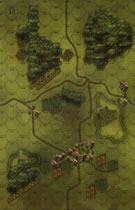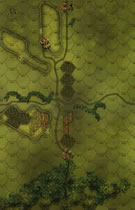|
Last Stand of the Podhale Rifles Polish Exiles #9 |
||
|---|---|---|
| (Attacker) Germany | vs | Poland (Defender) |
| Formations Involved | ||
|---|---|---|
| Germany |  |
7th Panzer Division |
| Poland |  |
Podhale Rifle Brigade |

|
| Overall Rating, 0 votes |
|---|
|
0
|
| Scenario Rank: --- of 958 |
| Parent Game | Polish Exiles |
|---|---|
| Historicity | Historical |
| Date | 1940-06-18 |
| Start Time | 00:14 |
| Turn Count | 24 |
| Visibility | Day |
| Counters | 101 |
| Net Morale | 0 |
| Net Initiative | 1 |
| Maps | 2: 31, 33 |
| Layout Dimensions | 56 x 43 cm 22 x 17 in |
| Play Bounty | 233 |
| AAR Bounty | 222 |
| Total Plays | 0 |
| Total AARs | 0 |
| Battle Types |
|---|
| Exit the Battle Area |
| Inflict Enemy Casualties |
| Road Control |
| Scenario Requirements & Playability | |
|---|---|
| Deluge | Counters |
| Fall of France 2 | Maps + Counters |
| Polish Exiles | Base Game |
| Introduction |
|---|
|
Combourg, France The Podhale Rifle Brigade departed Narvik, Norway on 1 June, arriving in Greenock, Scotland on the 12th. The British soldiers sharing the convoy disembarked, and on the 14th the Polish brigade sailed for Brest, France. By this point, it was obvious that French resistance could not last much longer. But the Poles sailed on, landing at Brest on 15 June with some troops landing at Lorient a day later. Coming under command of the French 10th Army, the Poles received orders from Gen. Marie-Robert Altmayer to move forward to the eastern border of Brittany and slow the German advance against the port of St. Malo. There the 1st Canadian Division and other troops of the "Second BEF" were embarking for England, having seen no combat, and the Poles were expected to hold off the Germans long enough for them to complete their escape. Brigade commander Zygmunt Bohusz-Szysko faced an ethical dilemma; the Poles had agreed to follow French operational orders but he considered this deployment at best stupid and at worst suicidal. He compromised by sending one of his four battalions to Combourg, where they dug in to await the onrushing Germans. They didn't have to wait for long. |
| Conclusion |
|---|
|
The lone Polish battalion held up the Germans long enough to allow the Canadian and British troops to embark safely in St. Malo, at the cost of enormous casualties. The Polish speed bump had done its job, without acknowledgement from the British of French commands; local Bretons have not forgotten and still hold annual remembrance services more than eight decades later. Even as his men died, Bohusz-Szysko received confirmation from his Polish commander-in-chief, Wladyslaw Sikorski. HE was to ignore any further orders from the French to sacrifice his men, and re-embark for England. French Gen. Antoine Béthouart, who had commanded the Narvik expedition, urged the Poles to leave as quickly as possible. The brigade staff landed in Plymouth the next day, and most of the troops the day after in Southampton. The brigade would be disbanded later in the summer, with its troops assigned to new formations of a new army in exile. |
| Additional Notes |
|---|
|
Special Rules
Use French 25mm AT counters to represent the Polish units. There is a DIY countersheet for a Polish version of the French substitute counters. Counters from White Eagles may be used instead of those from The Deluge. |

 PoEx008
PoEx008 





























